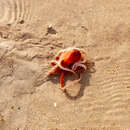Comprehensive Description
(
İngilizce
)
Smithsonian Contributions to Zoology tarafından sağlandı
Octopus kaurna Stranks, 1990
Octopus kaurna Stranks, 1990b:460, fig. 2a–f.
Octopus sp. B, Stranks, 1988a:61, figs. 26–30.
DIAGNOSIS.—Animals medium-sized (to 420 mm TL; to 85 mm ML). Mantle elongate ovoid (MWI 40–70–107); head wide, slightly narrower than mantle (HWI 37–58–89), demarked from mantle by minor constriction; eyes small, not projecting above surface of head. Funnel large, slender, bluntly tapered (FLI 44–61–89); funnel organ VV-shaped, limbs thick, outer limbs length of median limbs. Arms very long (ALI 144–686), slender, tapering to narrow tips. Arm lengths unequal, arm order I > II > III > IV. Suckers deeply set in flesh of arms, small (SI 3–5–9), without sucker enlargement. Right arm III of males hectocotylized, shorter than opposite arm (HAMI 144–249–326; OAI 54–61–70); ligula narrow, small (LLI 5–6–8); ligula groove well marked and moderately deep, with incomplete transverse ridges; calamus short, pointed (CLI 33–42–48); hectocotylized arm with 66–129 suckers. Web very shallow (WDI 11–14–19), web formula usually A > B > C & gt; D > E. Radula with B4-5 asymmetrical seriation of rachidian. Ink sac present. Gill lamellae 9–11 on outer demibranch. Mature female with large eggs (capsule 9–11 mm long, 2–3 mm wide), method of egg attachment to substrate unknown. Penis long (PLI 18–24–36), with large, single-coiled diverticulum; spermatophores relatively short (SpLI 52–83–103), slender (SpWI 3–4–5), with large, coiled sperm reservoir (SpRI 21–29–39).
Integumental sculpture consists of pattern of fine, rounded, and widely set epidermal tubercles. Tubercles largest on dorsum; tubercles smaller and less prominent on ventral surface. Some tubercles on ventrolateral surface more elongate but no more prominent than those on dorsal and ventral surfaces. Papillae in ocular region absent. Lateral integumentary ridge or fold around mantle circumference absent. In life, color of resting animals light brown to pink brown dorsally, cream to light brown ventrally; when stimulated, animals become darker brown to brick-red brown. Color of animals preserved in ethyl alcohol uniformly light brown to dark purple dorsally, creamy red to light brown ventrally. Ocelli absent.
ORIGINAL DESCRIPTION.—Stranks, 1990b:460, fig. 2a–f. See also Stranks, 1988a:61, figs. 26–30.
TYPE LOCALITY.—Australia, Victoria, Hobsons Bay (37°52′S, 144°56′E), no depth data.
TYPE.—Holotype: NMV F24494, male, 34 mm ML. Specimen in good condition, preserved in ethyl alcohol.
DISTRIBUTION AND BIOLOGY.—Endemic to temperate waters of southeastern Australia, from the Great Australian Bight to eastern Australia, including Bass Strait and northern Tasmania. An inshore species, living on sand bottom, and among seagrass, at depths of 0–49 m. Biology unknown.
- bibliyografik atıf
- Voss, N. A. and Sweeney, M. J. 1998. "Systematics and Biogeography of cephalopods. Volume II." Smithsonian Contributions to Zoology. 277-599. https://doi.org/10.5479/si.00810282.586.277
Octopus kaurna
(
İngilizce
)
wikipedia EN tarafından sağlandı
Octopus kaurna, also known as the southern sand octopus, is an octopus native to the waters around the Great Australian Bight and Tasmania.[2] It has an arm span of up to 50 cm (20 in) with long, unusually thin tentacles joined at the base by webbing and studded with small suckers. The species was first identified by Timothy Nathaniel Stranks. Kaurna is the name of an Australian Aboriginal clan which lived in the Adelaide region of South Australia.[3]
Behaviour
Unlike most octopuses, O. kaurna lacks color-changing chromatophors. However, it is able to hide from predators by burrowing itself in sand. The process begins with the octopus using its siphon to inject water into the sand, creating quicksand-like conditions which enable burrowing. Then, it uses its arms to burrow into the sand. Two arms will be extended to the surface, creating a ventilation shaft. At the same time, O. kaurna will use mucus to stabilize the shape of the burrow. Finally, the octopus will retract its two arms and push out loose sand with its siphon, creating a mucus-lined, ventilated burrow to rest in. While many octopuses bury themselves in a shallow layer of sediment for camouflage, O. kaurna is the only known species to exhibit sub-surface burrowing.[4]
References

- lisans
- cc-by-sa-3.0
- telif hakkı
- Wikipedia authors and editors
Octopus kaurna: Brief Summary
(
İngilizce
)
wikipedia EN tarafından sağlandı
Octopus kaurna, also known as the southern sand octopus, is an octopus native to the waters around the Great Australian Bight and Tasmania. It has an arm span of up to 50 cm (20 in) with long, unusually thin tentacles joined at the base by webbing and studded with small suckers. The species was first identified by Timothy Nathaniel Stranks. Kaurna is the name of an Australian Aboriginal clan which lived in the Adelaide region of South Australia.
- lisans
- cc-by-sa-3.0
- telif hakkı
- Wikipedia authors and editors
Octopus kaurna
(
Felemenkçe; Flemish
)
wikipedia NL tarafından sağlandı
Octopus kaurna is een soort in de taxonomische indeling van de inktvissen, een klasse dieren die tot de stam der weekdieren (Mollusca) behoort. De inktvis komt enkel in zout water voor en is in staat om van kleur te veranderen. Hij beweegt zich voort door water in zijn mantel te pompen en het er via de sifon weer krachtig uit te persen. De inktvis is een carnivoor en zijn voedsel bestaat voornamelijk uit vis, krabben, kreeften en weekdieren die ze met de zuignappen op hun grijparmen vangen.
De inktvis komt uit het geslacht Octopus en behoort tot de familie Octopodidae. Octopus kaurna werd in 1990 beschreven door Stranks.[1]
Bronnen, noten en/of referenties
- lisans
- cc-by-sa-3.0
- telif hakkı
- Wikipedia-auteurs en -editors
Habitat
(
İngilizce
)
World Register of Marine Species tarafından sağlandı
shelf
van der Land, J. (ed). (2008). UNESCO-IOC Register of Marine Organisms (URMO).
- lisans
- cc-by-4.0
- telif hakkı
- WoRMS Editorial Board

